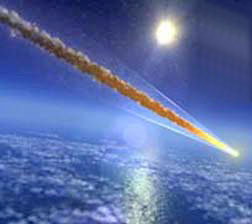|

The Last
Attempt to Find Mysterious Celestial Body
Translated by: Guerman Grachev
07/30/2005 13:47
from
EnglishPravda Website
Researchers are
looking for a location
where parts of the huge
celestial body hit the earth
Despite a great deal of information people know about this world, it
is still full of mysteries. Space regularly creates phenomena that
perplex the ever inquisitive earthlings. Researchers have long been
studying the celestial bodies which "had come into close contact"
with Earth i.e. meteorites and comets.
A fourth expedition of Russian scientists is due to set off on
August 1st from Bodaibo. The expedition will be
looking for an impact site of a celestial body known as "the
Vitim meteorite." Researchers are confident that they
will find a location where parts of the huge celestial body hit the
earth. The meteorite exploded some 30 km above the ground in 2002.
The previous three expeditions ended in failure.
 This
time around the expedition leaders are confident that the latest
recalculations pertaining to the impact site are true. The
recalculations are based on seismic data. Scientists hope to see
evidence proving their hypothesis. They believe evidence may reveal
itself as a large number of felled trees, broken branches of the
trees, and traces of the meteorite embedded in the wood. There is no
hope to discover any large fragments because the meteorite was
actually torn asunder into tiny particles by the immense explosion. This
time around the expedition leaders are confident that the latest
recalculations pertaining to the impact site are true. The
recalculations are based on seismic data. Scientists hope to see
evidence proving their hypothesis. They believe evidence may reveal
itself as a large number of felled trees, broken branches of the
trees, and traces of the meteorite embedded in the wood. There is no
hope to discover any large fragments because the meteorite was
actually torn asunder into tiny particles by the immense explosion.
The expedition will be the final attempt to find the traces of
the Vitim meteorite. The participants say they are going to call
it a day and scratch the project should they fail to succeed this
time. The longstanding dispute over the origin of the meteorite will
be resolved if pieces of the celestial body are found. Some
scientists persistently claim that the meteorite in question was a
comet.
The participants of the expedition are keen to unravel one more
mystery. The mystery refers to the so-called Kolpakov cone.
The cone is a crater-like formation sitting on the side of a
mountain. Not unlike the well-known lunar craters, the Kolpakov
cone has a small heap at its bottom. The cone is 70 meters in
diameter. It is composed of individual blocks of limestone.
Scientists have been holding heated debates over the origin of the
cone since the day it was discovered back in 1949. Some say that the
Kolpakov cone is yet another trace of the giant meteorite.
Others believe that the crater was formed by a powerful underground
explosion. Some scientists even believed that the crater had been
formed by a piece of the legendary Tunguska meteorite. The above
theory has been fully disproved by now.
Geologists and astronomers intend to continue their research of the
Kolpakov cone as opposed to the Vitim meteorite
project which could be shelved subject to results of the upcoming
expedition. Their intentions are pretty understandable. The Vitim
meteorite still exists only as an event recorded by satellites as
they monitored the earth's atmosphere. On the contrary, the
Kolpakov cone is a material object.
|